The ants become a metaphor for sweeping social change. If the ants came into the air one at a time, they would not be able to find each other. Instead, taking flight all at the same time allows them to swarm the air, find each other, and have a much more massive effect—so, too, with the women as the novel progresses.
